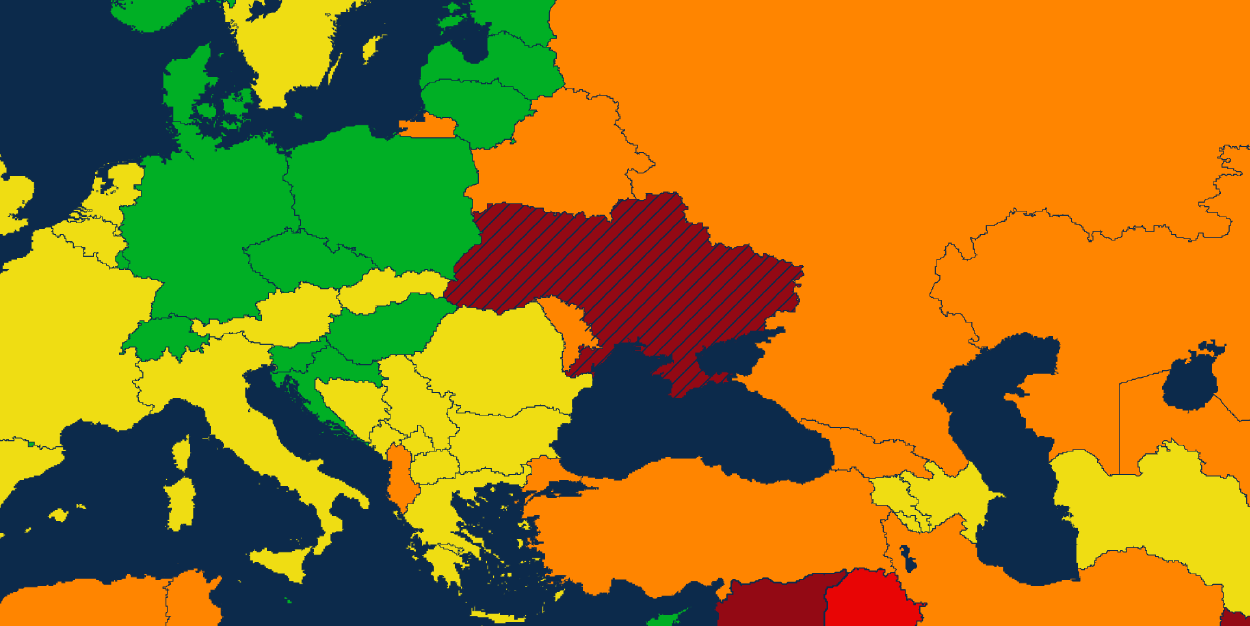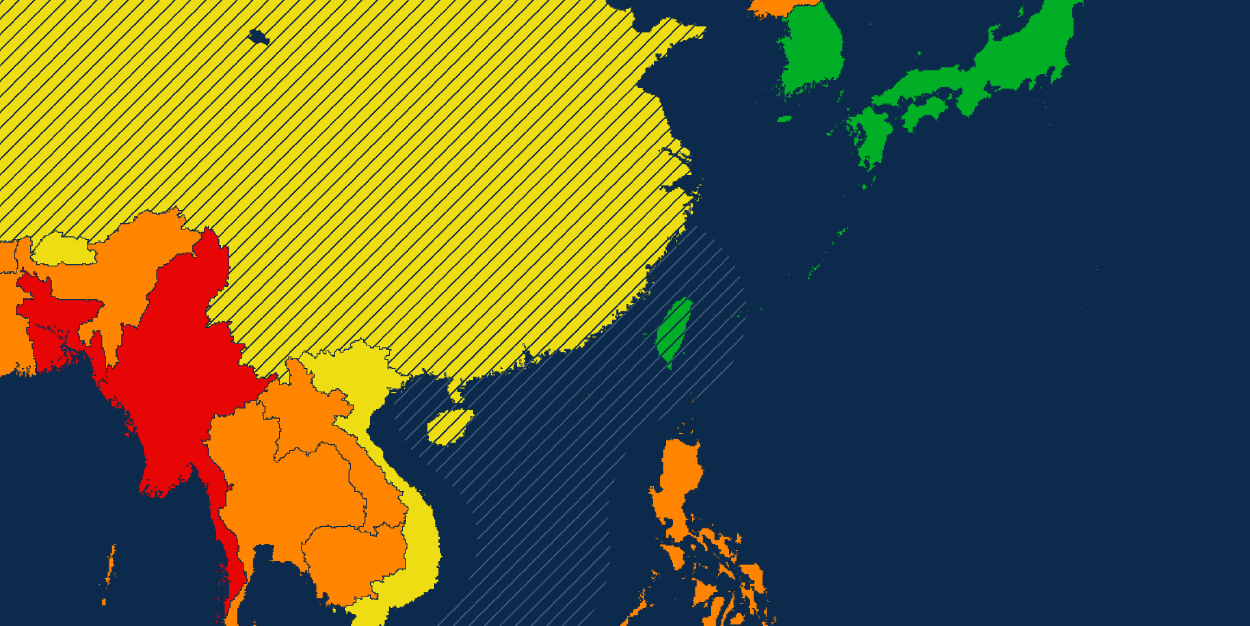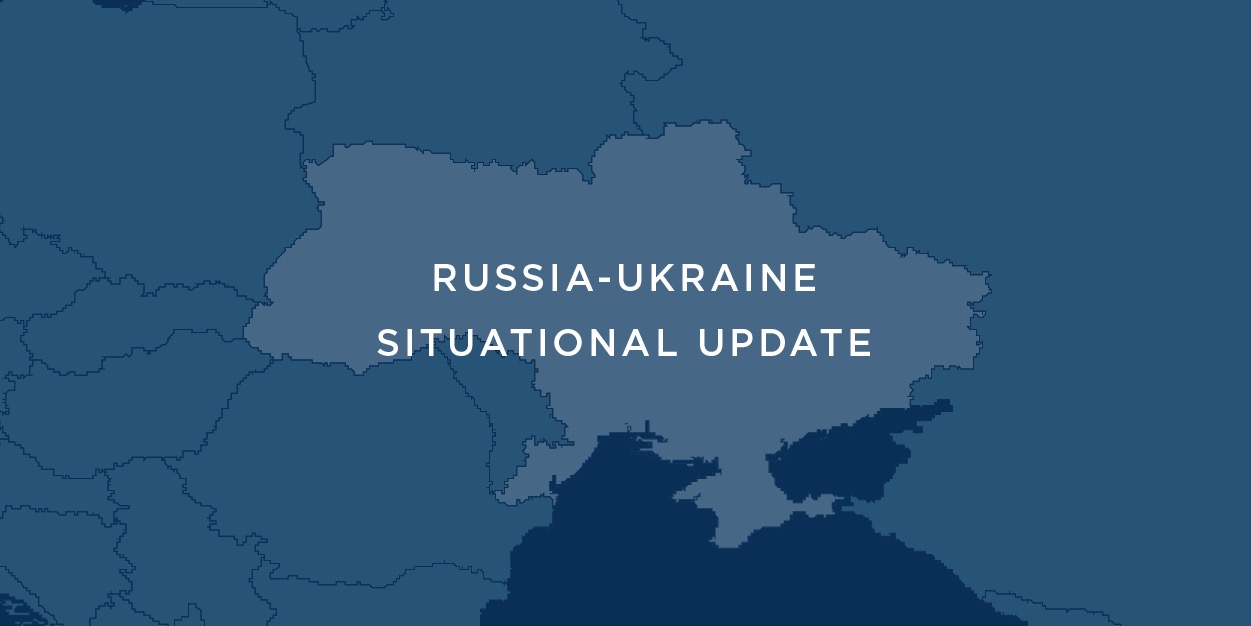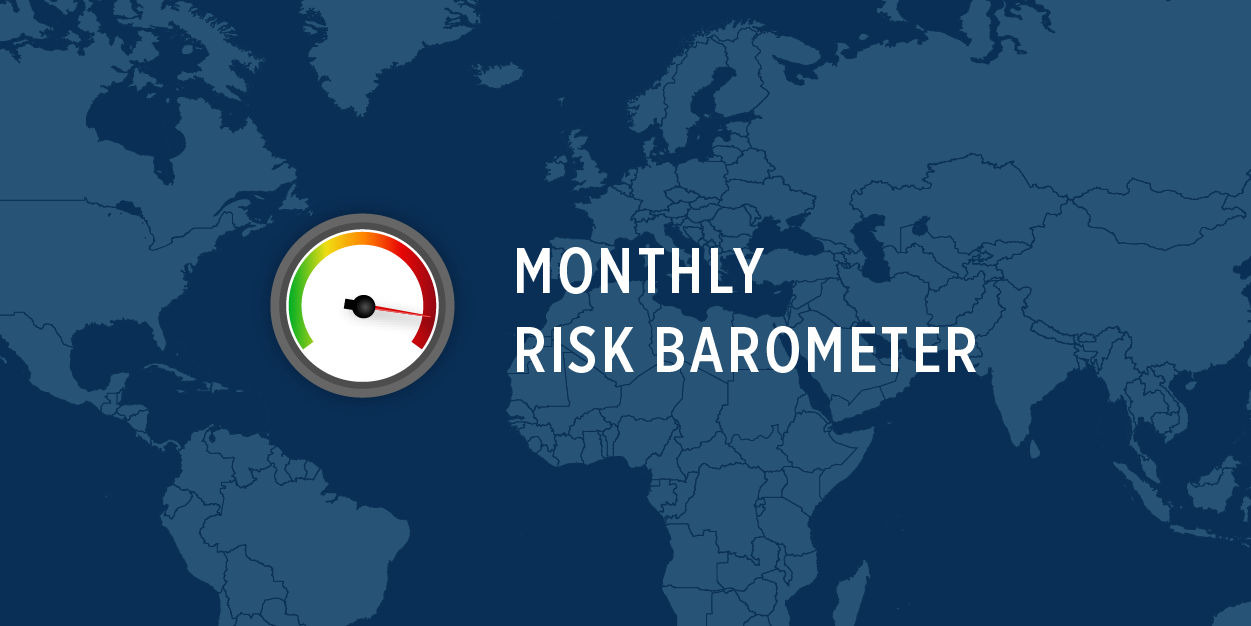In Global Guardian's new monthly Risk Barometer, our team of intelligence analysts will brief on current global hotspots with the potential to impact your business operations and travels. Read below for analysis on the threats we are closely monitoring this month and click here to subscribe for regular intelligence updates, including this monthly report.
WAR ENTERS NEW AND MORE DANGEROUS PHASE
Russia’s response to the Ukrainian counter-offensive has ushered in a new and more dangerous phase of the war. As Russia races to replenish its depleted forces along the frontlines, President Putin is simultaneously employing three tools: partial mobilization, energy warfare on Europe, and nuclear brinksmanship to wrestle back the momentum of the war. There is a real danger, albeit with a low likelihood, of the use of a tactical nuclear weapon, should Ukraine make significant strategic gains before winter weather plays a factor and newly mobilized Russian reinforcements arrive.
In September, the Armed Forces of Ukrainian conducted a major offensive in the northeastern Kharkiv region. Through effective planning and execution, and with the help of new western supplied hardware and U.S. intelligence, Ukrainian forces liberated approximately 10,608km² of territory, including over 400 towns. On 03 October, Ukraine captured the strategic of town of Lyman in Donetsk which was a massive military blow to the Russian war effort and marks the first settlement now claimed by Russia that Ukraine has retaken. Strategically, with Lyman now under its control, Ukraine can now march towards Svatove, which will serve as a gateway to rest of Luhansk. Meanwhile in the south, Ukrainian forces have made many gains in Kherson oblast on the west bank of the Dnipro and are poised to rout the 15,000 Russian defenders there.
In response to the slew of battlefield losses, Putin announced the partial mobilization of up to 300,000 Russian citizens with specialist training and military experience on 21 September, though other accounts suggest the mobilization is much wider. In conjunction with the mobilization, Russia formally annexed Kherson, Zaporizhzhia, Luhansk, and Donetsk oblasts on 30 September following what have been described as sham referenda. Reports of up to 700,000 Russians have fled the country in the last two weeks to avoid conscription, and protests against the mobilization have occurred throughout the country.
- The U.S. and other governments have warned that all dual citizens in Russia may be drafted and should depart immediately.
- The rapidly devolving situation underscores the need for geopolitical intelligence briefings.
Analysis
The annexation of the four Ukrainian oblasts were meant to dissuade Kyiv from continuing its counter-offensive and convince its Western benefactors that continued financial and material support for Ukraine can lead to a more severe Russian response as Russia will now see Ukraine as attacking its territory. Putin’s threat to use “all means” is a tacit threat to use nuclear weapons, as Russian nuclear doctrine provides for the use of nuclear weapons if Russian soil is attacked.
Ukraine’s counteroffensive made Russia choose between defending its newly-occupied territory in the east (the Donbas) or the south as it did not have the manpower to repel Ukraine on both fronts. Russia prioritized the south and Ukraine was able to rapidly punch through Russia’s lines in parts of the Donbas. Russia’s current imperative is to prevent Ukraine from crossing the Dnipro River in Kherson before winter and reinforcements arrive. Putin will use any means at his disposal to accomplish this.
Evaluating the Nuclear Threat
On 04 October, the city of Kyiv began to distribute potassium iodine pills in preparation for a possible Russian nuclear attack. While unlikely still, the risk of a nuclear event has increased. In descending order, below are the possible scenarios:
Nuclear Test
- Aim: demonstrate resolve and willingness to employ tactical nuclear devices on the battlefield.
- Place the onus on NATO to respond to create a win-win scenario: either NATO elects to escalate, vindicating Putin’s worldview and justifying placing Russia on war footing, or NATO deescalates using sanctions or other non-kinetic means.
- Possible target: uninhabited area at high altitude in the Black Sea or in Siberia.
Low-Yield Tactical Nuclear Detonation
- Aim: freeze Ukrainian battleground gains. It would likely need to happen all at once and there would need to be sufficiently concentrated Ukrainian forces for the attack to be worth the cost.
- In order to take a such a risk, Russia would need to be close to losing areas of paramount strategic and symbolic importance, including combinations of Crimea and the cities of Donetsk or Luhansk.
Nuclear Attack on Kyiv
- Aim: to shock the Ukrainian government into surrender.
- This is a highly unlikely scenario for several reasons to include probable confrontation with NATO, fomenting domestic dissent, and alienating Russia from its few partners.
KEY TAKEAWAYS Russia is rapidly losing territory in Ukraine and has upped the stakes in this conflict by annexing territory it cannot hold in the short term. Russia needs to bide time until it has mobilized sufficient forces to cement its territorial gains. Russia has already begun to resort to nuclear brinksmanship. Should Ukrainian forces cross the Dnipro River in the south or begin to cede areas previously held by pro-Russian separatists before reinforcements arrive, there is a non-zero chance that Russia deploys tactical nuclear weapons to stem the tide of Ukrainian advances. |
Caucuses Flare Up Indicates Potential for Wider Azerbaijani-Armenian Conflict
Azerbaijan’s recent incursion into Armenia proper represents the biggest escalation in the Nagorno-Karabakh conflict since the 2020 war. The outcome of the ongoing peace talks will have considerable implications for the security and stability of the region. If an agreement is not reached in the next month, renewed fighting—including full-scale war—is possible. Renewed fighting has the potential to affect an energy corridor that runs from the Caspian Sea to Europe which has become an increasingly important alternative to Russian energy since the invasion of Ukraine.
On 13 September, Azerbaijan conducted an assault on Armenia’s southern border regions with shelling and fighting affecting the cities of Vardenis, Sotk, Artanish, Ishkhanasar, Goris and Kapan. More than 200 Armenians, mostly soldiers, were killed in the clashes, making this flare up the deadliest since the 2020 Nagorno-Karabakh War. Violence on the border was accompanied by demonstrations in Armenia’s capital Yerevan where protesters and opposition leaders have been calling for the resignation of Prime Minister Nikol Pashinyan. Pashinyan’s opponents are critical of the government’s efforts to reach a peace deal with Azerbaijan which they characterize as appeasement.
- Western embassies have advised their personnel not to travel to the Armenian provinces of Syunik, Vayots Dzor, southern Gegharkunik, the village of Yeraskh, and the main road connecting Yerevan to Tbilisi through the Tavush region.
- Monitoring the political situation in Armenia and pre-trip intelligence is recommended ahead of travel to Yerevan.
Context
The conflict is rooted in security, ethnicity, and historical grievance. The Nagorno Karabakh region comprises the eastern portion of the Armenian plateau, making it a naturally defensible border, and has an ethnically Armenian majority. Upon the dissolution of the Soviet Union, calls within the region for unification with Armenia developed into a full-scale war between Armenia and Azerbaijan. This resulted in a painful and humiliating defeat for Azerbaijan which lost 16% of its territory to de facto Armenian control and saw more than 750,000 of its people displaced.
Current Azerbaijani president Ilhan Aliyev has relied on the anti-Armenian sentiment and revanchism inspired by this defeat to foster domestic support for his regime. Anti-Armenian rhetoric in Azerbaijan has manifested in the desecration of Armenian cultural sites and official denial of the Armenian genocide. Azerbaijani forces have also been accused of war crimes—in both this latest incursion as well as the 2020 Nagorno-Karabakh war—including the torture and execution of prisoners. The most recent Azerbaijani incursion into Armenia proper represents a significant escalation in the conflict as previous military action had been confined to Nagorno-Karabakh. Azerbaijan asserts that its most recent actions were a response to Armenian provocations but have not supplied any supporting evidence for its claim.
Looking Forward
Russia and the EU are independently brokering peace deals while the U.S. has urged Azerbaijan to stand down, but if an agreement is not reached in the next month, renewed fighting—including a full-scale war—is possible. Azerbaijan has few reasons not to press their advantages which include the support of Turkey, a distracted Russia, and energy leverage over Europe. The Caucuses represent the only existing corridor through which central Asian and Caspian oil and gas can reach Europe given recent Russian energy embargoes. While the U.S. appears eager to fill the power vacuum left by Russia, it is yet unclear whether Washington is willing to exert sufficient pressure on Baku to avert escalation.
Key Takeaways The most recent Azerbaijani incursion into Armenia proper represents an escalation in the conflict that could foreshadow the resumption of war. A wider conflict has the potential to threaten the increasingly important pipelines that run from the oil and gas reservoirs of the Caspian and central Asia to the European energy market. The United States has signaled an intention to fill the role of peacemaker in the region as Russia is embroiled in Ukraine; however, the U.S. has little leverage to exercise. |
Border Wars in a Post-Russian Central Asia
While further escalation along the Kyrzgzstan-Tajikistan border is unlikely in the short-term, hope for long term solutions is limited in the current political climate. The most recent clash’s involvement of regular military units and ethno-nationalist rhetoric in both countries represents an escalation from previous border clashes and indicates the potential for future skirmishes to grow into more significant conflicts. A wider border war could threaten foreign investments and personnel in the region.
More than 100 people were killed and nearly 137,000 evacuated during clashes between the two central Asian republics in mid-September. Both sides accused the other of escalation in a two-day border conflict which included the use of heavy weapons such as tanks, artillery, and drones in addition to small arms. More than 300 civilian structures were damaged or destroyed during the fighting, and the Batken airport (БАТ) in Kyrgyzstan was shelled. Fighting has stopped as the two sides agreed on a ceasefire effective on 18 September.
- Do not travel to the region surrounding the Vorukh enclave.
- Monitoring the political situation in the region and pre-travel intelligence is recommended ahead of trips to border areas.
Context
While the ceasefire has held thus far, the underlying causes of the conflict have yet to be addressed. Kyrgyzstan and Tajikistan were born out of the nationality policies enacted under Soviet leadership in the 1920’s. During the Soviet era, the border between the two states was largely symbolic, as Kyrgyz, Tajik, and other resident peoples had common access to resources—principally water and pastureland—in and around the border region. Today, competition for resources is exacerbated by poorly delineated borders that were made intentionally convoluted by Josef Stalin. Nearly half of the 600-mile Kyrgyz-Tajik border is disputed.
Civilian disputes over water and grazing pasture often escalate into armed conflicts between border guards and regular army units. Confrontations over resources also occurred in 2004, 2005, 2008, 2011, 2014, 2015, and 2021. Tajikistanis and Kyrgyzstanis living upstream of one another will block canals and streams flowing across the border in response to perceived grievances, thus exacerbating the conflict and weaponizing the water supply itself.
Strategic Implications
As Russia—the traditional peace broker in such post-Soviet disputes—loses international standing, the formerly Soviet republics may come under increased Chinese influence, especially in light of the region’s importance to China’s Belt-and-Road Initiative (BRI). The United States also has commercial and counter-terror interests in the region and could take advantage of Russian absence in its historical sphere of influence.
The weaponization of water and failure to develop lasting solutions to resource disputes indicates a potential source of conflict in the nearby Fergana valley, one of the most densely populated regions in the world. The area is already prone to border conflicts involving Tajikistan and Kyrgyzstan, as well as Uzbekistan. If resource management agreements do not materialize, these disputes threaten to exacerbate and amplify any other destabilizing factors that affect the region.
KEY TAKEAWAYS The border conflict between Kyrgyzstan and Tajikistan does not pose a significant threat of escalation in the short term, but the root causes of tension in the region—issues of resource management and the artificial borders—show no signs of dissipating. The degradation of Russian influence in the region is creating a vacuum that both the United States and China have strategic interests in filling. |
Swedish General Election Outcome Underscores Growing Travel Risk in Sweden
Sweden’s recent election of a right-wing coalition comes as the population has become frustrated by surging levels of gang violence, specifically gun crime and bombings. While most of the violence is conducted between rival criminal organizations, recent bomb scares at popular events and shootings in central and southern Sweden highlight the danger to travelers.
On 11 September, a right-wing coalition led by the Moderate Party ended eight years of Social Democrat control through a campaign that centered on law and order. Center-left parties had consistently led in the polls in the run up to the election, but two high-profile shootings just before voting day saw a dramatic spike in the popularity of the far-right Sweden-Democrats party. The new ruling coalition is likely to take a harder line on immigration and augment police budgets and powers.
Precipitating Events
On 19 August, a man was killed and a woman wounded in a gang-related shooting in a popular shopping center south of Malmö. On 26 August, a woman and her child were wounded in the crossfire of a gang shootout in Eskilstuna in central Sweden. A few days earlier, on 21 August, a bag with an “unknown object” was found near Café Opera in Kungsträdgården, central Stockholm, during the final night of a major cultural festival. The bag was safely cordoned and detonated by the police causing a large explosion, and confirming fears that the bag contained a substantial, and potentially functional explosive device. The identity and the motives of the would-be bomber are yet unknown. This incident underscores the risk that Swedish gang violence and the associated availability of explosives pose to civilians.
- Consider secure transportation and executive protection when visiting all areas of Sweden.
Analysis
This year has already become the deadliest on record for gang-related violence in Sweden. So far in 2022 there have been 48 shooting deaths and 76 bombings as both guns and grenades have become increasingly accessible. Swedish cities such as Malmö and Göteborg have become notorious as amongst Europe’s most dangerous and gang-related shootings have propelled the country’s gun-homicide rate up to 4.5 times the European average. At the present rate Sweden is primed to overtake Croatia as Europe’s leader in gun deaths per capita.
While deadly shootings have risen steadily since 2005, their impact has shifted. Historically, gang-violence was confined to the suburbs of Stockholm, Göteborg, and Malmö, but smaller cities and rural areas have become increasingly affected. In May, three men were executed within eight-days in the small city of Orebro. Numerous security incidents were reported in small towns and rural areas throughout the month of August.
The social alienation, economic inequality, and limited employment opportunities experienced by first- and second-generation Swedes combined with a lucrative drug trade and increasing access to weaponry have fueled the violence. The lack of evidence left behind by detonated IEDs and the prevailing attitude towards the police in many immigrant communities have complicated Swedish officials’ abilities to crack down on the violence.
Looking Forward
Sweden’s far-right groups have been expanding their strength and membership as the country becomes more dangerous. There are growing concerns that should Sweden’s police continue to struggle to scale back the threat from gang violence, far-right groups may engage in “vigilante” violence against immigrant communities. The new right-wing government is expected to augment police budgets, which may help reduce violence in the short term. But the Sweden-Democrats party’s history of anti-immigrant rhetoric has civil rights groups concerned that the new government’s policies will inflame instead of redress the root causes of violence.
Recent Events
- 01 October: One person was injured in a shooting at an unspecified location near Landskrona north of Malmö.
- 29 September: Two people were injured in a shooting at a residence in Enköping, a suburb of Stockholm.
- 28 September: Multiple sources reported a shooting along Robert Anbergsvag in Södertälje, a suburb of Stockholm. One person was injured.
- 27 September: A suspicious device was safely defused in Slottsskogen park in Gothenberg.
- 22 September: Multiple sources reported a powerful explosion in a stairwell of a residential building along Bygatan in the Huvudsta area of Stockholm. At least two injuries were reported. The explosion resulted in extensive damage to the building and surrounding area.
- 18 September: A suspicious device was discovered at a pier located near Storgatan and Norrstacksvagen.
KEY TAKEAWAYS The frequency and extent of gang violence in Sweden is cause for travelers to take increased pre-cautions when traveling to and around the country. Recent political developments in Sweden have the potential to exacerbate the issue in the long term. |
















